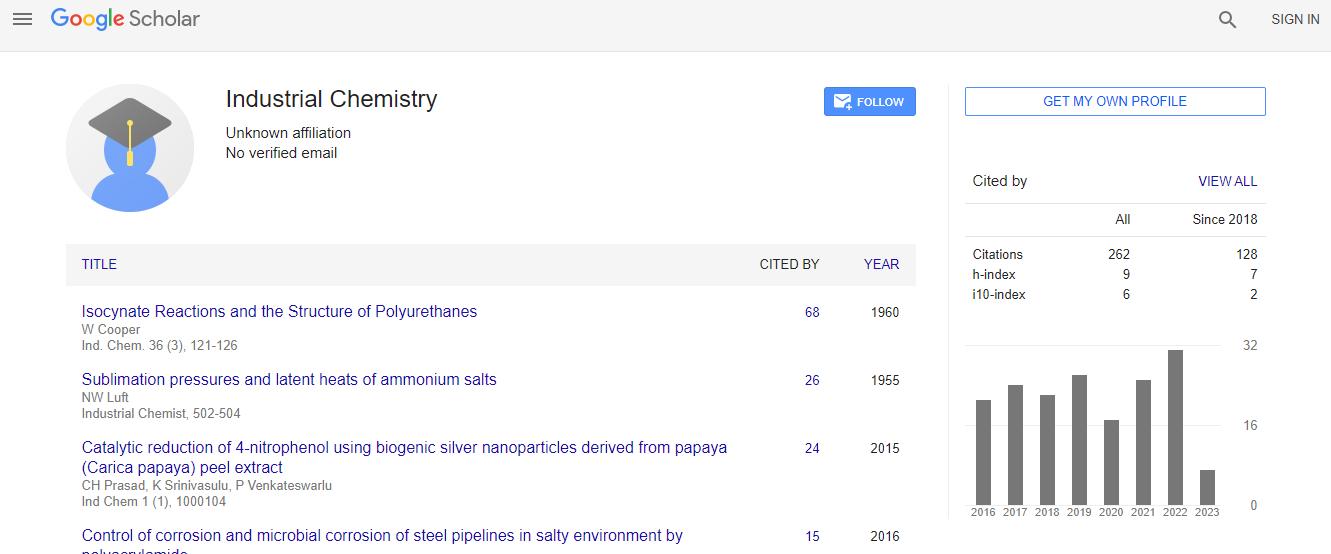Our Group organises 3000+ Global Conferenceseries Events every year across USA, Europe & Asia with support from 1000 more scientific Societies and Publishes 700+ Open Access Journals which contains over 50000 eminent personalities, reputed scientists as editorial board members.
Open Access Journals gaining more Readers and Citations
700 Journals and 15,000,000 Readers Each Journal is getting 25,000+ Readers
Google Scholar citation report
Citations : 262
Industrial Chemistry received 262 citations as per Google Scholar report
Indexed In
- Index Copernicus
- Google Scholar
- RefSeek
- Directory of Research Journal Indexing (DRJI)
- Hamdard University
- EBSCO A-Z
- OCLC- WorldCat
- Scholarsteer
- Geneva Foundation for Medical Education and Research
- Euro Pub
Useful Links
Recommended Journals
Related Subjects
Share This Page
The potential of natural gelatin generated from Sisymbrium irio seed in water treatment processes
2nd World Conference on Industrial Chemistry and Water Treatment
Soraya Hosseini, Salman Masoudi Soltani and Mohamed Kheireddine Aroua
University of Malaya, Malaysia Imperial College London, UK
ScientificTracks Abstracts: Ind Chem
Abstract
Many treatment methods have been proposed for removal of pollutants from water. The feasibility of a natural gelatin from Sisymbrium irio seeds to remove dyes (methylene blue, and methyl orange) and reducing turbidity of kaolin water has been examined. Various natural materials were applied for removal of dyes, heavy metals, organic compounds and reducing turbidity from wastewater; however, some issues such as the presence of poisoning materials appeared due to utilization of those natural materials. Sisymbrium irio seed is widely used as medicine for treating some disease, indicating the edible seed is free poisoning. Various enzymatic degradation products are formed from Sisymbrium irio seed when the seed tissue is disrupted due to content glucosinolates. These products contribute to adsorbing anionic and cationic dyes from water in which the dyes are totally removed in all pH range of solutions; however, reduction in turbidity of kaolin water was not observed. The highest amount of natural gelatin was obtained in the pH range 5 to 7. A color reduction of over 99% was achieved at equilibrium using an methylene blue concentration of 200 mg/L with 5 g seed in the pH range 3 to 10 and also 98% methyl orange was removed in the pH range 5 to 10. A color changing of the Sisymbrium irio seed was observed form orange to dark blue after removal of methylene blue. The results show that the enzymatic degradation products are totally able to remove both cationic and anionic dyes that may have occurred due to bonding with various functional groups such as OH, SO3, SH, CN, etc. For this reason, no flocculation occurred in kaolin water without any surface charge to reduce turbidity.Biography
Soraya Hosseini has completed her PhD in Chemical Engineering from University Kembangan Malaysia in 2010, followed by a series of Post-doctoral positions at University Putra Malaysia from 2010 to 2016 within the same department. Her PhD and the subsequent postdoctoral research have led to about 45 research papers published in high-profile scientific journals in the field. Although she has been actively involved in environmental research and catalyst fabrication, her main research interest falls in the area of the fabrication of anhydrous membranes in fuel cell application. She has also been developing a growing interest in the area of advanced materials and electrochemical reactions. She has also conducted in-depth research on the fabrication of biosensors, employed in a range of food and energy. Her current research is concentrated around the fabrication of biosensors and probing into their performance by means of electrochemical reaction and impedance spectroscopy.
Email: soraya20h@gmail.com

 Spanish
Spanish  Chinese
Chinese  Russian
Russian  German
German  French
French  Japanese
Japanese  Portuguese
Portuguese  Hindi
Hindi 